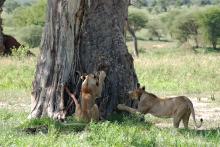Adansonia digitata
Common name:
Baobab
African Baobab
Monkey-bread Tree
Pronunciation:
ad-an-SOH-nee-uh dig-ee-TAH-tuh
Family:
Bombacaceae
Genus:
Type:
Broadleaf
Native to (or naturalized in) Oregon:
No
- Deciduous tree, leafs out during the period of maximum heat just before the first rains arrive in a tropical environment. It may grow to 65 ft (~20 m) high, with a massive trunk that is cylindrical, tapering, bottle-shaped or irregular; with a bare lower part. The top, divides into stiff upward-pointing branches, giving the impression of a bottle full of twigs. Leaves simple (especially juvenile) or palmately compound, with 5-9 leaflets, elliptic to ovate, dark glossy green; petiole to 16 cm. Flowers often open before the leaves, they are white, large, 9 × 7 cm, on a long, hanging stalk, 20-90 cm long. Fruits form up to six months after flowering, during the late dry season or early wet season. They vary from spherical to oblong and slender to ovoid, measuring 12-40 cm in length and 7-17 cm in diameter. They become woody and gourd-like and when ripe they contain a powdery pulp and many kidney-shaped, brownish black or purple seeds.
- Sun Baobabs can grow in climates where the temperature gets into the high 40°C (104°F plus).
- Hardy to USDA Zone (10?) 11(tropical) It occurs throughout semiarid continental Africa, from the Senegal coast to northern South Africa. It is particularly plentiful in the Sudano-Sahelian zone and is renowned in Madagascar, where it was probably introduced by Arab traders. It is sometimes grown in Hawaii.
- The Baobab is a source of food and drink: Some count this tree’s leaves among their most valued vegetables. Others consider its fruits the finer food And all rely on baobab seed for sustenance during famine times. For more see The Baobab is a source of food and drink.
- digitata: divided from a common point, like fingers on a hand (same as palmate).












